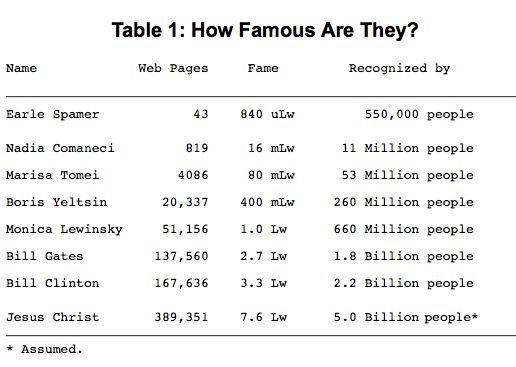Scientific Minds Want To Know

by Eric Schulman
Abstract
Yes.
1. Introduction
Although "fame" is an important concept, most previous studies of fame have been almost purely qualitative in nature. The reason for this is that fame was very difficult to quantify until recently. However, with the advent of the World-Wide Web, it is now possible to measure fame quantitatively.
In this paper we will introduce a method of quantitatively measuring the fame of an individual, show the results of this method for eight selected individuals, suggest a new unit of measurement for fame, and draw some conclusions.
2. Methods
We used the AltaVista Search Engine (http://www.altavista.com/); searches were performed on March 9, 1999) to determine how many web pages mention the eight people chosen for our study. For example, searching on "earle spamer" resulted in 43 web pages being found, while searching on "jesus christ" resulted in 389,351 web pages being found.
3. Results
The number of web pages that mention each of the eight people in our study can be found in Table 1. This table also includes two more parameters: the fame of each person and an estimate of how many people would immediately recognize each person's name. These parameters are discussed in the next section.

4. Discussion
Because this new method is the first to offer a quantitative definition of fame, none of the standard systems of units--mks (meters-kilograms-seconds), cgs (centimeters-grams-seconds), or fsf (furlongs-slugs-fortnights)--includes a unit of fame.
 We
propose to remedy this problem by suggesting that the standard unit of
fame be called the Lewinsky (Lw), where 1 Lewinsky is the number of web
pages that mention Monica Lewinsky. In this system, Earle Spamer has a
fame of 840 microLewinskys, while Jesus Christ has a fame of 7.6
Lewinskys.
We
propose to remedy this problem by suggesting that the standard unit of
fame be called the Lewinsky (Lw), where 1 Lewinsky is the number of web
pages that mention Monica Lewinsky. In this system, Earle Spamer has a
fame of 840 microLewinskys, while Jesus Christ has a fame of 7.6
Lewinskys.Note that the fame listed above is a relative--not absolute--quantity. So while we know that Jesus Christ is 9054.7 times more famous than Earle Spamer, we don't really know how famous either of these individuals is in isolation. We can, however, overcome this disadvantage by making the reasonable assumption that about 80% of the people on Earth would immediately recognize the name "Jesus Christ." We can then estimate how many people on Earth would recognize any of the other people on our list.
The referee suggested to us that the relationship between a person's fame and the number of web pages that mention that person isn't necessarily linear. However, since a linear theory is more elegant than a theory that predicts a more complicated relationship, we concluded that the linear theory must be correct.
5. Conclusions
Fame is not constant with time, but by using the method we have presented here, one can determine the relative and absolute fame of any individual at any given time simply by using AltaVista to make three searches: a search on "monica lewinsky", a search on "jesus christ," and a search on the individual's name.
In this paper we introduced a method of quantitatively measuring the fame of an individual, showed the results of this method for eight selected individuals, suggested a new unit of measurement for fame, and drew some conclusions.

No comments:
Post a Comment